coolant temperature CHEVROLET KODIAK 2004 Owners Manual
[x] Cancel search | Manufacturer: CHEVROLET, Model Year: 2004, Model line: KODIAK, Model: CHEVROLET KODIAK 2004Pages: 366, PDF Size: 6.87 MB
Page 84 of 366
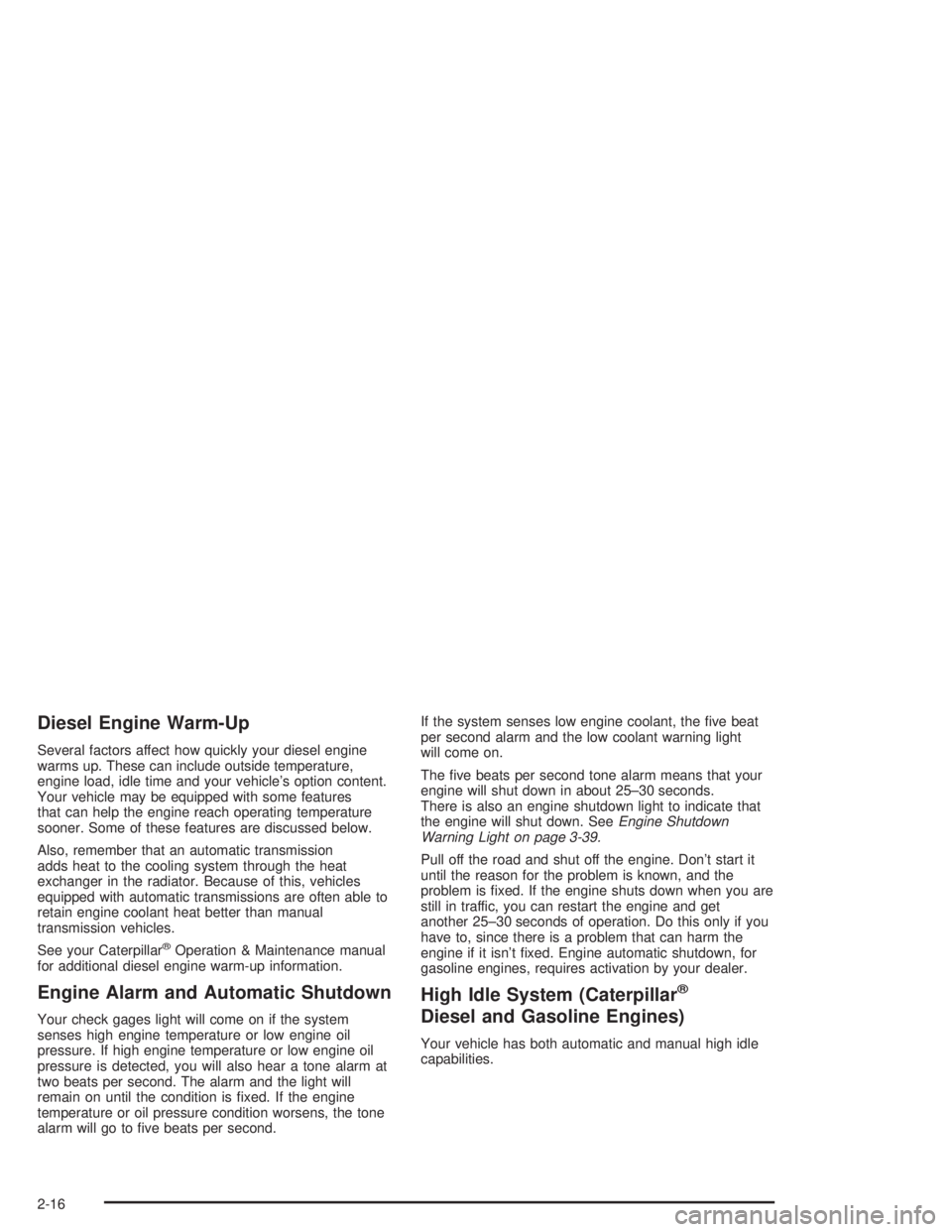
Diesel Engine Warm-Up
Several factors affect how quickly your diesel engine
warms up. These can include outside temperature,
engine load, idle time and your vehicle’s option content.
Your vehicle may be equipped with some features
that can help the engine reach operating temperature
sooner. Some of these features are discussed below.
Also, remember that an automatic transmission
adds heat to the cooling system through the heat
exchanger in the radiator. Because of this, vehicles
equipped with automatic transmissions are often able to
retain engine coolant heat better than manual
transmission vehicles.
See your Caterpillar
®Operation & Maintenance manual
for additional diesel engine warm-up information.
Engine Alarm and Automatic Shutdown
Your check gages light will come on if the system
senses high engine temperature or low engine oil
pressure. If high engine temperature or low engine oil
pressure is detected, you will also hear a tone alarm at
two beats per second. The alarm and the light will
remain on until the condition is fixed. If the engine
temperature or oil pressure condition worsens, the tone
alarm will go to five beats per second.If the system senses low engine coolant, the five beat
per second alarm and the low coolant warning light
will come on.
The five beats per second tone alarm means that your
engine will shut down in about 25–30 seconds.
There is also an engine shutdown light to indicate that
the engine will shut down. SeeEngine Shutdown
Warning Light on page 3-39.
Pull off the road and shut off the engine. Don’t start it
until the reason for the problem is known, and the
problem is fixed. If the engine shuts down when you are
still in traffic, you can restart the engine and get
another 25–30 seconds of operation. Do this only if you
have to, since there is a problem that can harm the
engine if it isn’t fixed. Engine automatic shutdown, for
gasoline engines, requires activation by your dealer.
High Idle System (Caterpillar®
Diesel and Gasoline Engines)
Your vehicle has both automatic and manual high idle
capabilities.
2-16
Page 86 of 366
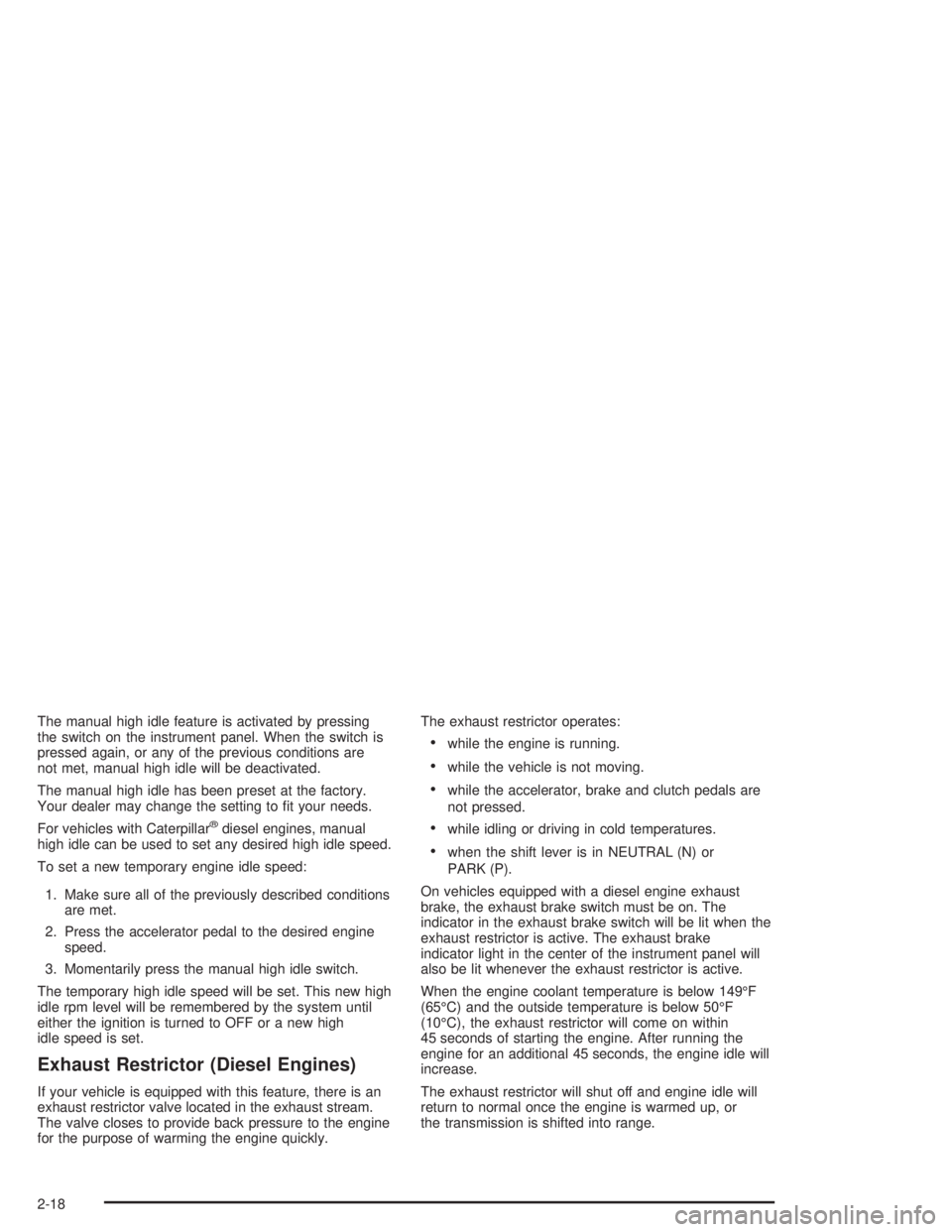
The manual high idle feature is activated by pressing
the switch on the instrument panel. When the switch is
pressed again, or any of the previous conditions are
not met, manual high idle will be deactivated.
The manual high idle has been preset at the factory.
Your dealer may change the setting to fit your needs.
For vehicles with Caterpillar
®diesel engines, manual
high idle can be used to set any desired high idle speed.
To set a new temporary engine idle speed:
1. Make sure all of the previously described conditions
are met.
2. Press the accelerator pedal to the desired engine
speed.
3. Momentarily press the manual high idle switch.
The temporary high idle speed will be set. This new high
idle rpm level will be remembered by the system until
either the ignition is turned to OFF or a new high
idle speed is set.
Exhaust Restrictor (Diesel Engines)
If your vehicle is equipped with this feature, there is an
exhaust restrictor valve located in the exhaust stream.
The valve closes to provide back pressure to the engine
for the purpose of warming the engine quickly.The exhaust restrictor operates:
•while the engine is running.
•while the vehicle is not moving.
•while the accelerator, brake and clutch pedals are
not pressed.
•while idling or driving in cold temperatures.
•when the shift lever is in NEUTRAL (N) or
PARK (P).
On vehicles equipped with a diesel engine exhaust
brake, the exhaust brake switch must be on. The
indicator in the exhaust brake switch will be lit when the
exhaust restrictor is active. The exhaust brake
indicator light in the center of the instrument panel will
also be lit whenever the exhaust restrictor is active.
When the engine coolant temperature is below 149°F
(65°C) and the outside temperature is below 50°F
(10°C), the exhaust restrictor will come on within
45 seconds of starting the engine. After running the
engine for an additional 45 seconds, the engine idle will
increase.
The exhaust restrictor will shut off and engine idle will
return to normal once the engine is warmed up, or
the transmission is shifted into range.
2-18
Page 88 of 366
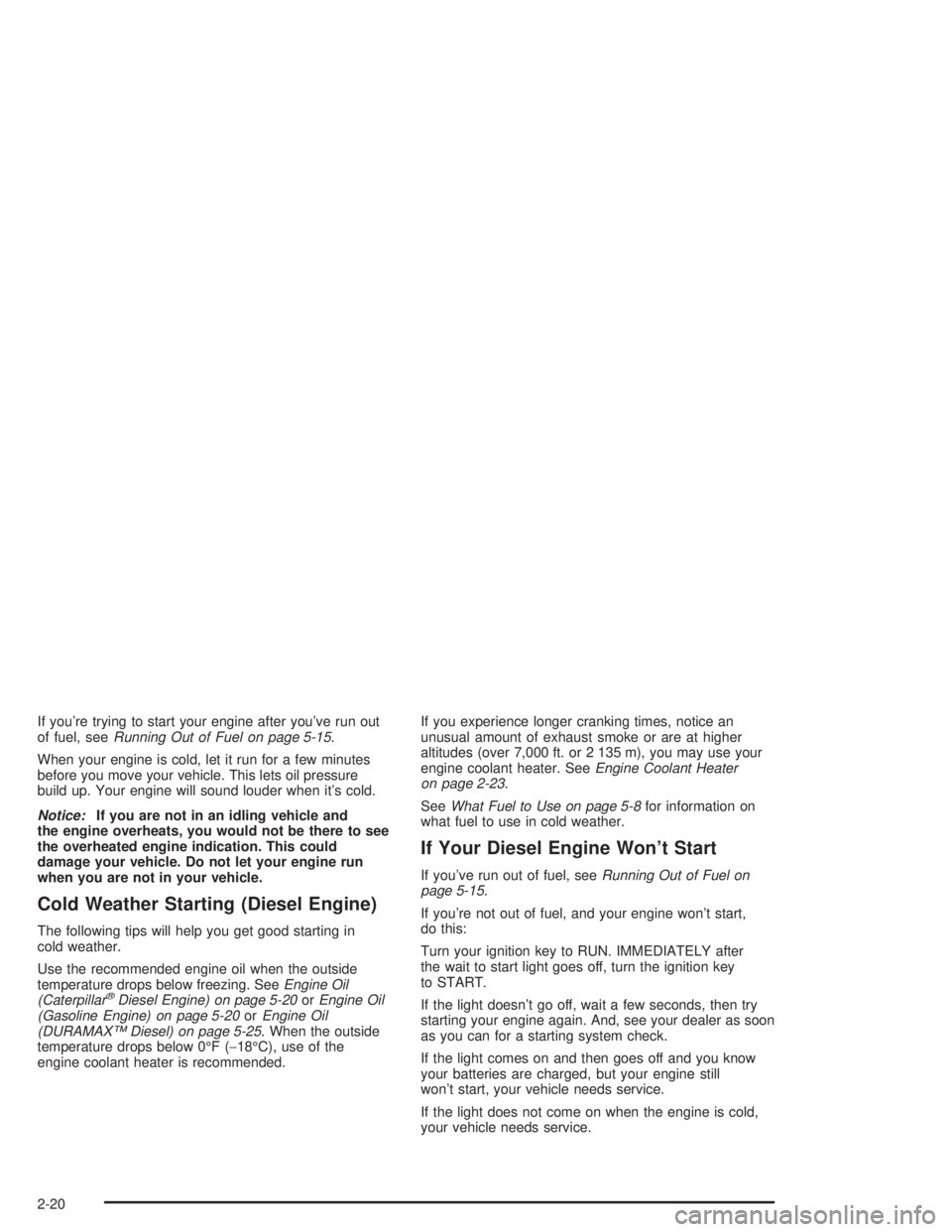
If you’re trying to start your engine after you’ve run out
of fuel, seeRunning Out of Fuel on page 5-15.
When your engine is cold, let it run for a few minutes
before you move your vehicle. This lets oil pressure
build up. Your engine will sound louder when it’s cold.
Notice:If you are not in an idling vehicle and
the engine overheats, you would not be there to see
the overheated engine indication. This could
damage your vehicle. Do not let your engine run
when you are not in your vehicle.
Cold Weather Starting (Diesel Engine)
The following tips will help you get good starting in
cold weather.
Use the recommended engine oil when the outside
temperature drops below freezing. SeeEngine Oil
(Caterpillar
®Diesel Engine) on page 5-20orEngine Oil
(Gasoline Engine) on page 5-20orEngine Oil
(DURAMAX™ Diesel) on page 5-25. When the outside
temperature drops below 0°F (−18°C), use of the
engine coolant heater is recommended.If you experience longer cranking times, notice an
unusual amount of exhaust smoke or are at higher
altitudes (over 7,000 ft. or 2 135 m), you may use your
engine coolant heater. SeeEngine Coolant Heater
on page 2-23.
SeeWhat Fuel to Use on page 5-8for information on
what fuel to use in cold weather.
If Your Diesel Engine Won’t Start
If you’ve run out of fuel, seeRunning Out of Fuel on
page 5-15.
If you’re not out of fuel, and your engine won’t start,
do this:
Turn your ignition key to RUN. IMMEDIATELY after
the wait to start light goes off, turn the ignition key
to START.
If the light doesn’t go off, wait a few seconds, then try
starting your engine again. And, see your dealer as soon
as you can for a starting system check.
If the light comes on and then goes off and you know
your batteries are charged, but your engine still
won’t start, your vehicle needs service.
If the light does not come on when the engine is cold,
your vehicle needs service.
2-20
Page 89 of 366

If your batteries don’t have enough charge to start your
engine, seeBattery on page 5-55.
Be sure you have the right oil for your engine, and that
you’ve changed the oil at the proper times. If you
use the wrong oil, your engine may be harder to start.
Be sure you are using the proper fuel for existing
weather conditions. SeeWhat Fuel to Use on page 5-8.
If the engine starts, runs a short time, then stops,
your vehicle needs service.
{CAUTION:
Do not use gasoline or starting “aids” such as
ether, in the air intake. They could damage
your engine. There could also be a �re, which
could cause serious personal injury.
Elevated Idle/Exhaust Restrictor
If your vehicle is equipped with the RPO LLY engine, it
has a cold temperature high idle and exhaust restrictor
feature which elevates the engines idle speed from
680 to 1200 rpms, and restricts the exhaust gas flow,
when outside temperatures are below 41°F (5°C),
and the engine coolant temperature is below
150°F (65°C.)
This feature enhances heater performance by raising
the engine coolant temperature faster. When the vehicle
is started in outside temperatures below 41°F (5°C),
and the engine coolant temperature is below 150°F
(65°C), the engine will idle at 1200 rpms and the
variable nozzle turbocharger will restrict the
exhaust flow.
To turn on this feature:
1. Turn the ignition to the run position, with the
vehicle off.
2. Press the accelerator pedal to the floor and hold
while quickly pressing the brake pedal three times
in less than eight seconds.
3. Release the accelerator pedal and start the engine.
2-21
Page 90 of 366
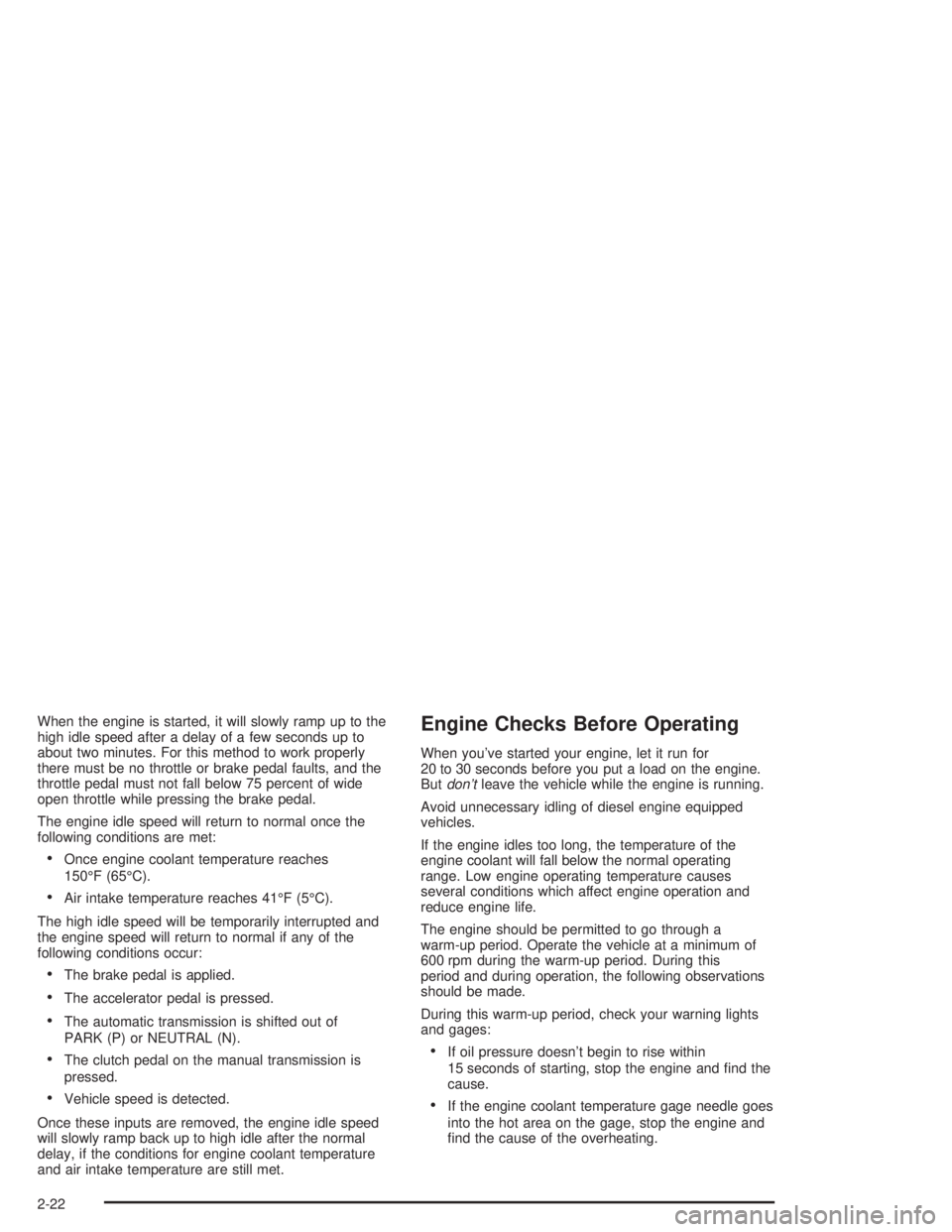
When the engine is started, it will slowly ramp up to the
high idle speed after a delay of a few seconds up to
about two minutes. For this method to work properly
there must be no throttle or brake pedal faults, and the
throttle pedal must not fall below 75 percent of wide
open throttle while pressing the brake pedal.
The engine idle speed will return to normal once the
following conditions are met:
•Once engine coolant temperature reaches
150°F (65°C).
•Air intake temperature reaches 41°F (5°C).
The high idle speed will be temporarily interrupted and
the engine speed will return to normal if any of the
following conditions occur:
•The brake pedal is applied.
•The accelerator pedal is pressed.
•The automatic transmission is shifted out of
PARK (P) or NEUTRAL (N).
•The clutch pedal on the manual transmission is
pressed.
•Vehicle speed is detected.
Once these inputs are removed, the engine idle speed
will slowly ramp back up to high idle after the normal
delay, if the conditions for engine coolant temperature
and air intake temperature are still met.
Engine Checks Before Operating
When you’ve started your engine, let it run for
20 to 30 seconds before you put a load on the engine.
Butdon’tleave the vehicle while the engine is running.
Avoid unnecessary idling of diesel engine equipped
vehicles.
If the engine idles too long, the temperature of the
engine coolant will fall below the normal operating
range. Low engine operating temperature causes
several conditions which affect engine operation and
reduce engine life.
The engine should be permitted to go through a
warm-up period. Operate the vehicle at a minimum of
600 rpm during the warm-up period. During this
period and during operation, the following observations
should be made.
During this warm-up period, check your warning lights
and gages:
•If oil pressure doesn’t begin to rise within
15 seconds of starting, stop the engine and find the
cause.
•If the engine coolant temperature gage needle goes
into the hot area on the gage, stop the engine and
find the cause of the overheating.
2-22
Page 91 of 366
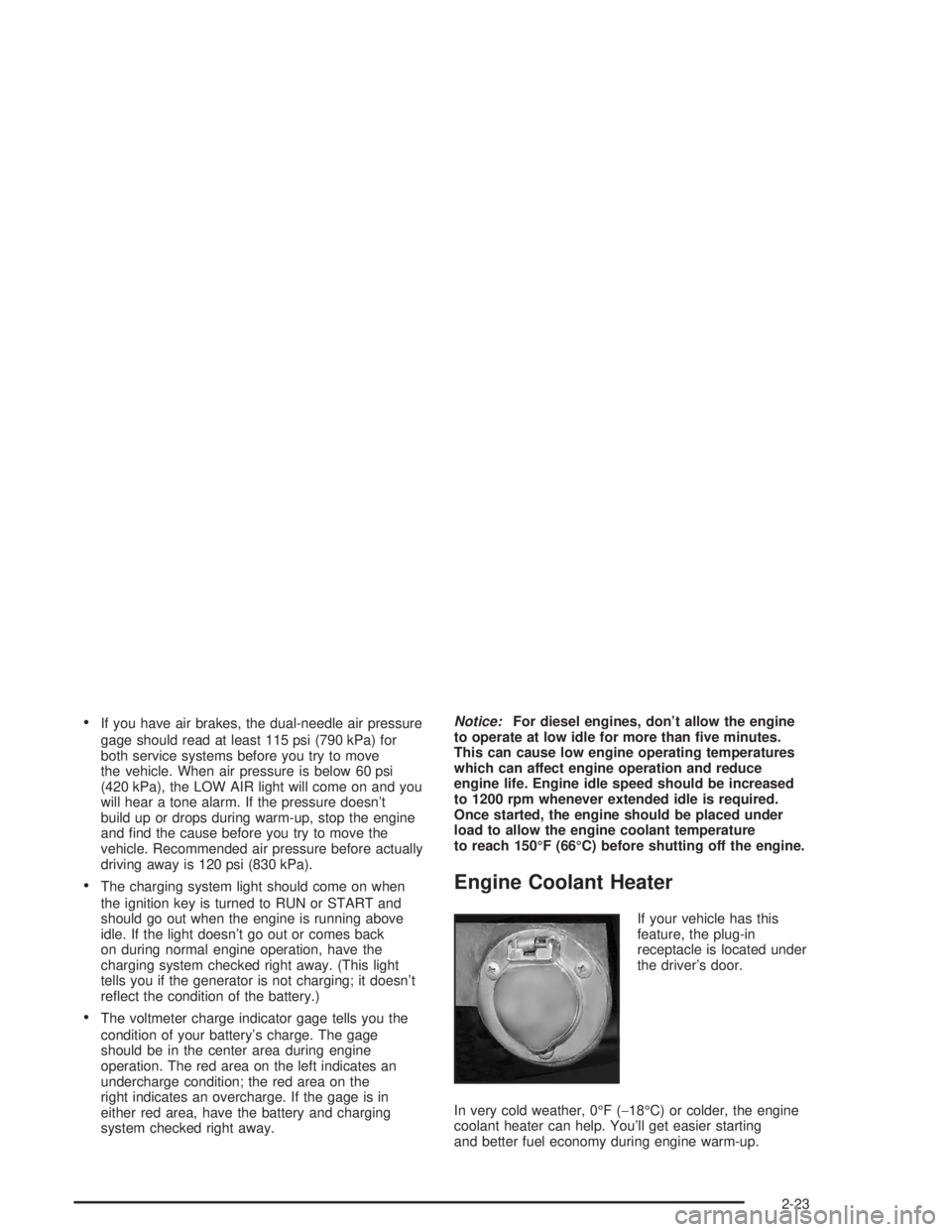
•If you have air brakes, the dual-needle air pressure
gage should read at least 115 psi (790 kPa) for
both service systems before you try to move
the vehicle. When air pressure is below 60 psi
(420 kPa), the LOW AIR light will come on and you
will hear a tone alarm. If the pressure doesn’t
build up or drops during warm-up, stop the engine
and find the cause before you try to move the
vehicle. Recommended air pressure before actually
driving away is 120 psi (830 kPa).
•The charging system light should come on when
the ignition key is turned to RUN or START and
should go out when the engine is running above
idle. If the light doesn’t go out or comes back
on during normal engine operation, have the
charging system checked right away. (This light
tells you if the generator is not charging; it doesn’t
reflect the condition of the battery.)
•The voltmeter charge indicator gage tells you the
condition of your battery’s charge. The gage
should be in the center area during engine
operation. The red area on the left indicates an
undercharge condition; the red area on the
right indicates an overcharge. If the gage is in
either red area, have the battery and charging
system checked right away.Notice:For diesel engines, don’t allow the engine
to operate at low idle for more than �ve minutes.
This can cause low engine operating temperatures
which can affect engine operation and reduce
engine life. Engine idle speed should be increased
to 1200 rpm whenever extended idle is required.
Once started, the engine should be placed under
load to allow the engine coolant temperature
to reach 150°F (66°C) before shutting off the engine.
Engine Coolant Heater
If your vehicle has this
feature, the plug-in
receptacle is located under
the driver’s door.
In very cold weather, 0°F (−18°C) or colder, the engine
coolant heater can help. You’ll get easier starting
and better fuel economy during engine warm-up.
2-23
Page 92 of 366

To Use the Engine Coolant Heater
1. Turn off the engine.
2. Find the plug-in receptacle located under the
driver’s door.
3. Plug a heavy-duty, three-prong extension cord
(rated for at least 15 amps) into the vehicle’s
plug-in receptacle first. Then plug the extension
cord into a normal, grounded 110-volt AC outlet.
{CAUTION:
Plugging the cord into an ungrounded outlet
could cause an electrical shock. Also, the
wrong kind of extension cord could overheat
and cause a �re. You could be seriously
injured. Plug the cord into a properly grounded
three-prong 110-volt AC outlet. Use a
heavy-duty three-prong extension cord rated
for at least 15 amps.4. Before starting the engine, be sure to unplug
the cord.
How long should you keep the coolant heater plugged
in? The answer depends on the outside temperature.
Usually, the coolant heater should be plugged in a
minimum of four hours prior to starting your vehicle.
From 32°F to−10° F (0°C to−23°C), keep the coolant
heater plugged in at least two hours. Below−10°F
(−23°C), keep the coolant heater plugged in for
a minimum of eight hours or overnight. It will not harm
either the coolant heater or the vehicle to leave the
coolant heater plugged in longer than the times stated.
Be sure to remove and store the cord before starting
the engine. SeeWhat Fuel to Use on page 5-8for
information on what fuel to use in cold weather.
2-24
Page 111 of 366
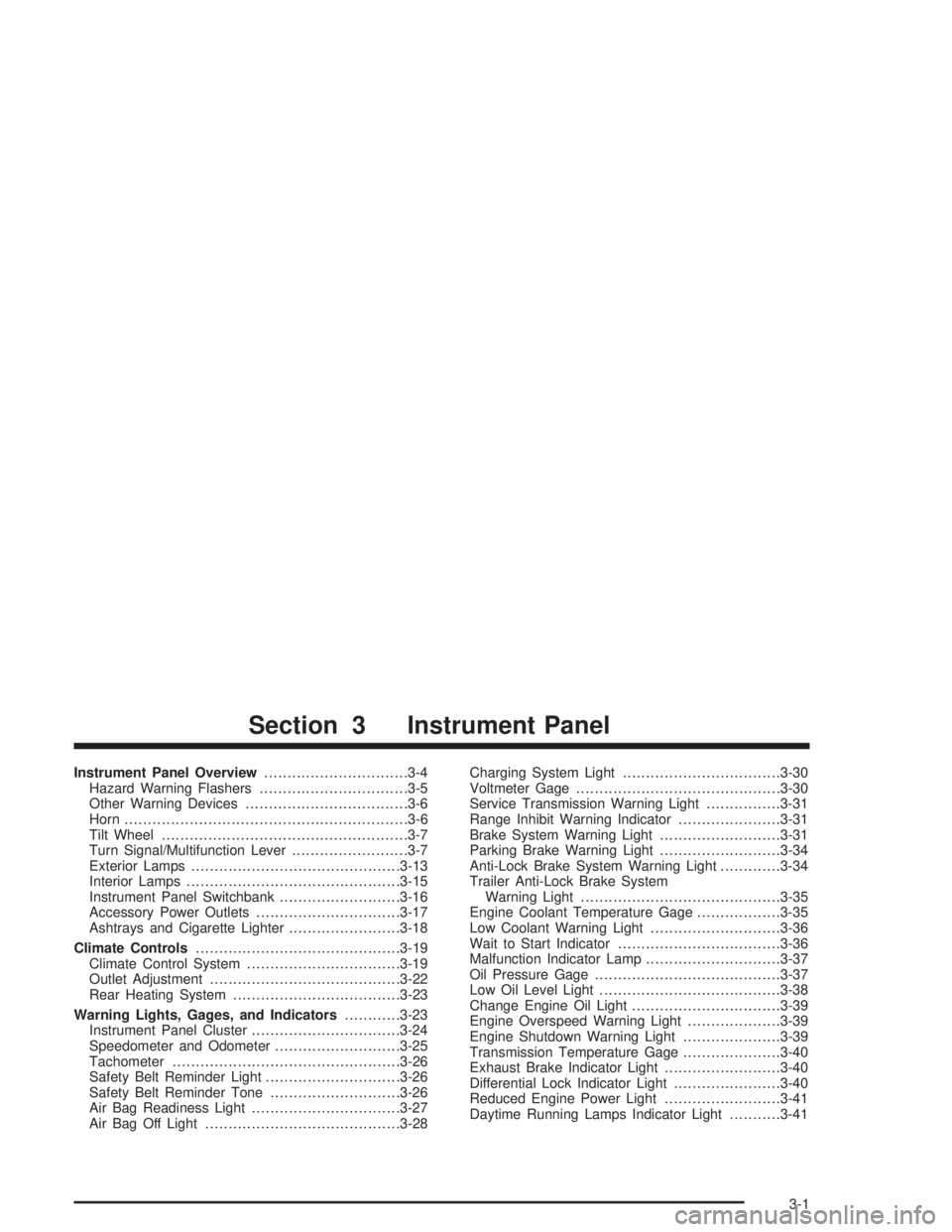
Instrument Panel Overview...............................3-4
Hazard Warning Flashers................................3-5
Other Warning Devices...................................3-6
Horn.............................................................3-6
Tilt Wheel.....................................................3-7
Turn Signal/Multifunction Lever.........................3-7
Exterior Lamps.............................................3-13
Interior Lamps..............................................3-15
Instrument Panel Switchbank..........................3-16
Accessory Power Outlets...............................3-17
Ashtrays and Cigarette Lighter........................3-18
Climate Controls............................................3-19
Climate Control System.................................3-19
Outlet Adjustment.........................................3-22
Rear Heating System....................................3-23
Warning Lights, Gages, and Indicators............3-23
Instrument Panel Cluster................................3-24
Speedometer and Odometer...........................3-25
Tachometer.................................................3-26
Safety Belt Reminder Light.............................3-26
Safety Belt Reminder Tone............................3-26
Air Bag Readiness Light................................3-27
Air Bag Off Light..........................................3-28Charging System Light..................................3-30
Voltmeter Gage............................................3-30
Service Transmission Warning Light................3-31
Range Inhibit Warning Indicator......................3-31
Brake System Warning Light..........................3-31
Parking Brake Warning Light..........................3-34
Anti-Lock Brake System Warning Light.............3-34
Trailer Anti-Lock Brake System
Warning Light...........................................3-35
Engine Coolant Temperature Gage..................3-35
Low Coolant Warning Light............................3-36
Wait to Start Indicator...................................3-36
Malfunction Indicator Lamp.............................3-37
Oil Pressure Gage........................................3-37
Low Oil Level Light.......................................3-38
Change Engine Oil Light................................3-39
Engine Overspeed Warning Light....................3-39
Engine Shutdown Warning Light.....................3-39
Transmission Temperature Gage.....................3-40
Exhaust Brake Indicator Light.........................3-40
Differential Lock Indicator Light.......................3-40
Reduced Engine Power Light.........................3-41
Daytime Running Lamps Indicator Light...........3-41
Section 3 Instrument Panel
3-1
Page 145 of 366
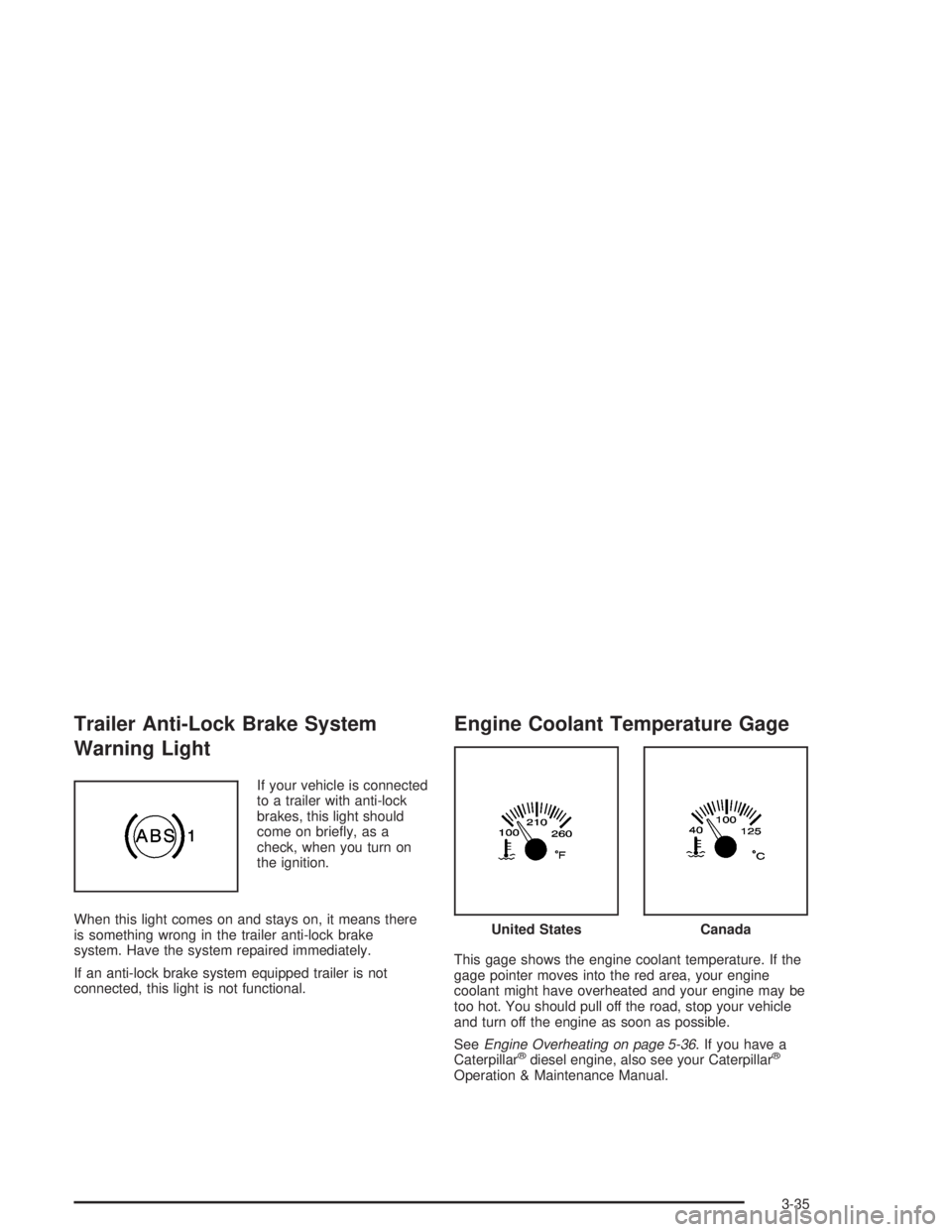
Trailer Anti-Lock Brake System
Warning Light
If your vehicle is connected
to a trailer with anti-lock
brakes, this light should
come on briefly, as a
check, when you turn on
the ignition.
When this light comes on and stays on, it means there
is something wrong in the trailer anti-lock brake
system. Have the system repaired immediately.
If an anti-lock brake system equipped trailer is not
connected, this light is not functional.
Engine Coolant Temperature Gage
This gage shows the engine coolant temperature. If the
gage pointer moves into the red area, your engine
coolant might have overheated and your engine may be
too hot. You should pull off the road, stop your vehicle
and turn off the engine as soon as possible.
SeeEngine Overheating on page 5-36. If you have a
Caterpillar
®diesel engine, also see your Caterpillar®
Operation & Maintenance Manual.
United StatesCanada
3-35
Page 152 of 366
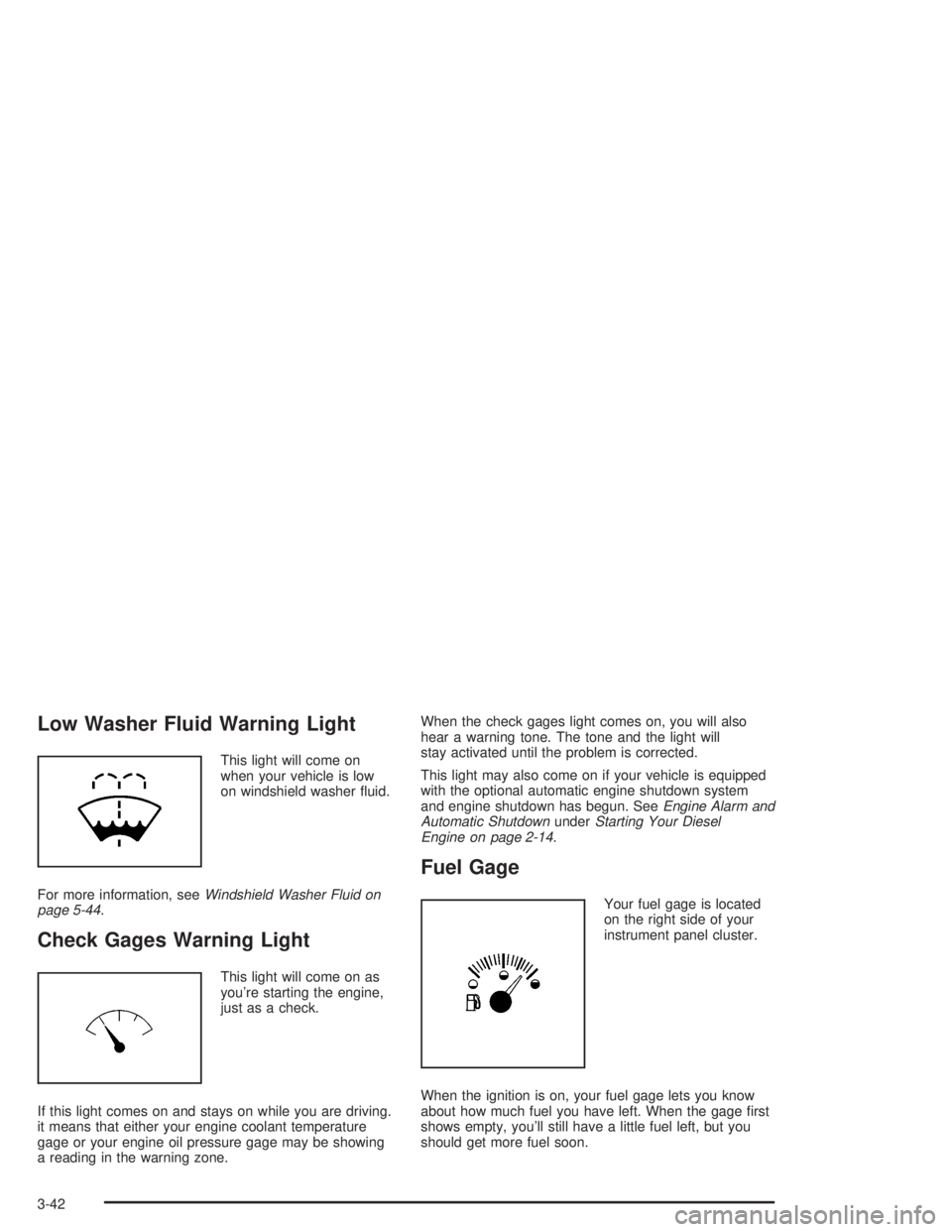
Low Washer Fluid Warning Light
This light will come on
when your vehicle is low
on windshield washer fluid.
For more information, seeWindshield Washer Fluid on
page 5-44.
Check Gages Warning Light
This light will come on as
you’re starting the engine,
just as a check.
If this light comes on and stays on while you are driving.
it means that either your engine coolant temperature
gage or your engine oil pressure gage may be showing
a reading in the warning zone.When the check gages light comes on, you will also
hear a warning tone. The tone and the light will
stay activated until the problem is corrected.
This light may also come on if your vehicle is equipped
with the optional automatic engine shutdown system
and engine shutdown has begun. SeeEngine Alarm and
Automatic ShutdownunderStarting Your Diesel
Engine on page 2-14.
Fuel Gage
Your fuel gage is located
on the right side of your
instrument panel cluster.
When the ignition is on, your fuel gage lets you know
about how much fuel you have left. When the gage first
shows empty, you’ll still have a little fuel left, but you
should get more fuel soon.
3-42